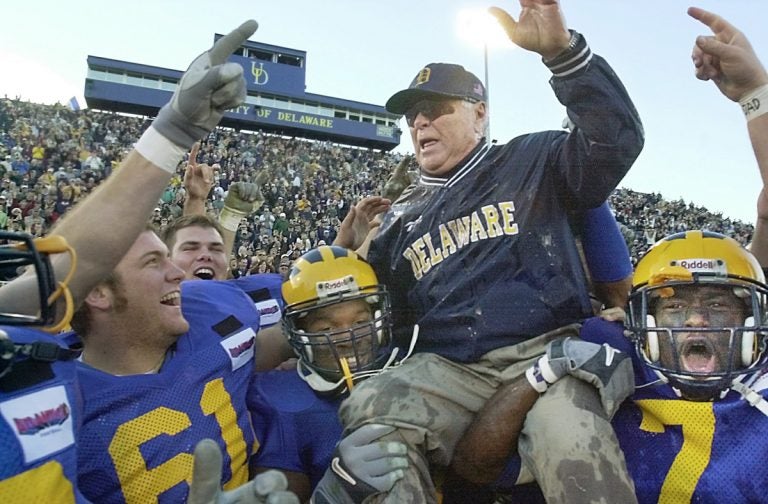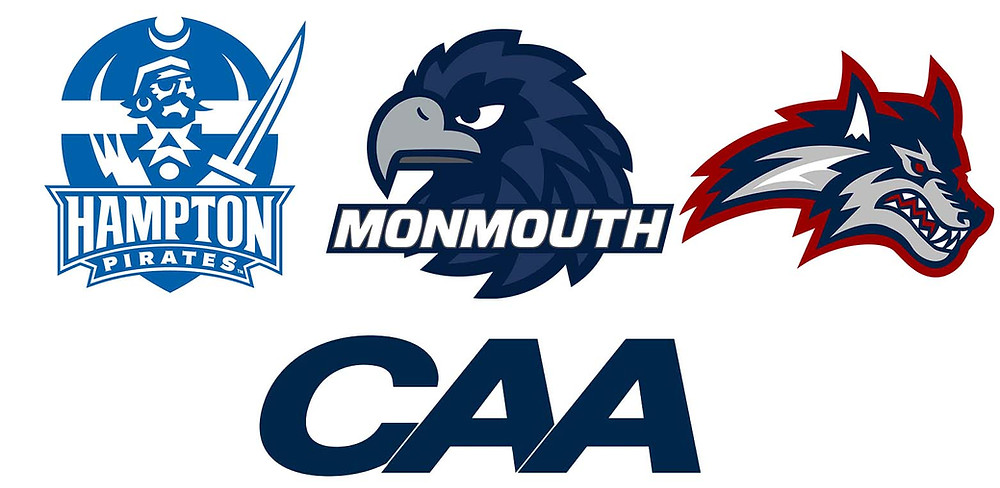OPINION: Are We On the Brink of the Era of the FCS Superconference?
This week, the Colonial Athletic Association made official what had been running through the rumor mill the past few weeks – Monmouth, Hampton, and Stony Brook accepted invitations to become members of the CAA this coming year.
Although the move seems designed primarily to beef up CAA basketball, which now becomes a 12 team conference, the move also adds two new football teams to CAA football – Monmouth and Hampton, which makes CAA football a 13 team conference. (Stony Brook was already a member of CAA football – they move from America East hoops to CAA hoops, and remain in the CAA in football, now as an all-sports member.)
The move has a significant impact on the Big South, Monmouth and Hampton’s previous conference. In the fall of 2022, they will be down to five football-playing members, which could eventually put their autobid to the FCS Playoffs in jeopardy.
But the CAA’s move to become a 13 team superconference begs a different question for the FCS – what if that’s the only way forward for any number of smaller FCS conferences? Are we on the brink of a new era, where five, six, and seven member conferences are a thing of the past?

The Midwest FCS Superconference
The idea of FCS “superconferences” is nothing new. In fact, you can make an excellent argument that this era is already here.
Take the “Missouri Valley Football Conference,” home of the defending-and-very-often-FCS-Champion North Dakota State Bison. Even thought it’s called the “Missouri Valley Football Conference,” it has quite a few members that play basketball elsewhere – including the Bison.
In fact, only Illinois State, Indiana State, Missouri State, Northern Iowa, Southern Illinois compete in the Missouri Valley in basketball and football. Five schools (North Dakota, North Dakota State, South Dakota State, Western Illinois) compete in the Summit League in basketball, while Youngstown State competes in the Horizon League.
The history of the “Missouri Valley Football Conference” was that it used to be called the Gateway Conference from 1985 to 2008.
The original Gateway conference was founded in the ashes of what used to be the Missouri Valley’s original football conference back in 1985, which essentially blew apart due to its schools having differing philosophies on whether to be I-A, I-AA, or I-AAA (or, in other words, dropping football.)
The conference was really a way to preserve the Missouri Valley teams that wanted to continue to play football at the FCS/I-AA level. There were three: Illinois State, Southern Illinois (who was fresh off a I-AA National Championship in 1982), and Indiana State. They joined Eastern Illinois, Northern Iowa, Southwest Missouri State, and Western Illinois to continue to play FCS football in the Midwest region.
For years the Gateway was a solid member of I-AA football, with Jim Tressel’s Youngstown State team capturing one National Championship as a member of the Gateway (after capturing three National Championships as a I-AA independent). Western Kentucky’s victory in 2002 gave the “superconference” two official FCS titles in its first twenty years (and was home to teams that had captured a grand total of six National Championships).
And that was before the Bison came along.
Members of the Summit League in basketball, once they transitioned to the FCS level, North Dakota and South Dakota State briefly competed in the Great West Football Conference, a five-team conference of convenience, before the Gateway allowed them to join. Shortly thereafter, the Gateway Football Conference rebranded itself to the Missouri Valley Football Conference, even though it is not technically administered by the main Missouri Valley all-sports Conference.
The schools in the Missouri Valley have benefited greatly from this “superconference” arrangement over the years. It has allowed the schools to play somewhat regionally in football, developing and harboring some fierce regional Rivalries, while keeping it separate from the operations of basketball and any Olympic sports the Missouri Valley, Summit, and Horizon sponsor.
It has also allowed the Missouri Valley Football Conference to align itself as the equivalent of the “SEC of the FCS” – a “power conference” with so many strong members that when the playoffs roll around, the question isn’t whether the conference will get at-large teams, but how many.

The Atlantic Coast FCS Superconference
The Colonial Athletic Association has done something similar as the Missouri Valley.
Back in 1997, the Atlantic 10 took over the operations of a football-only conference based in the Northeast called the Yankee Conference.
The Yankee Conference was an all-sports conference that competed from 1947 to 1976, based on the six land-grant New England schools forming its backbone (UConn, UMass, Vermont, New Hampshire, Rhode Island, and Maine). Other schools came and went, but it was these six schools that really dictated the direction.
When Vermont decided it would cease sponsoring football in 1975, it caused a crisis – while nobody wanted to stop playing the Catamounts in other sports, the leadership made a fateful decision to make the Yankee Conference an “optional” thing – member schools could pick and choose which sports they wanted to compete in. That started a process that effectively made the Yankee Conference a single-sport conference – I-AA football.
The Yankee Conference would limp on through the early part of the 1980s, eventually branching South to Delaware, Villanova (in football only) and James Madison. (Richmond and William and Mary briefly thought about joining a different upstart football league called the Patriot League, but quickly changed their minds once learning that the schools of the league were not going to offer football scholarships.)
From there the Yankee Conference was absorbed by the Atlantic 10 after the NCAA legislated that one-sport conferences would have less control over their sports’ policy. Even though only Rhode Island and UMass were all-sports members, the perceived clout of the Atlantic 10 name in Indianapolis made them the best partner.
It was in the Atlantic 10 that legendary Delaware head coach Tubby Raymond primarily competed during his hall-of-fame career.
The 2005 move of Northeastern, then a football-only member of the A-10, to the CAA in all sports started a chain of events that would end up with the dissolution of the A-10 Conference and the birth of “CAA Football”, a single-sport conference that had the CAA name but was really a “superconference”.
At that time, the CAA did not sponsor football, but five of its members did – Delaware, Hofstra, James Madison, Towson, and William & Mary.
When Northeastern joined, that gave the CAA six schools with football programs, which under NCAA rules allows a conference to sponsor football. Soon thereafter all the members of the old Atlantic 10 conference elected to join “CAA Football”, and since they had all competed together previously under the Atlantic 10 name, they were able to continue to have an autobid to the FCS Playoffs.
The schools in CAA Football have benefited greatly from this “superconference” arrangement over the years. Like the Missouri Valley, it has allowed the schools to play somewhat regionally in football, developing and harboring some fierce regional Rivalries, while keeping it separate from the operations of basketball. Critically, it has allowed some of its current members (Rhode Island, Richmond, Villanova) to continue to compete in the Atlantic 10 and Big East in basketball, keeping all three of these schools’ national ambitions in that area, while remaining regional in football.
It has also allowed the CAA to position itself as the elite FCS conference on the Atlantic Seaboard, quite literally now stretching from North Carolina to Maine. While its national power has ebbed and flowed, they have routinely fielded multiple teams in the FCS Playoffs yearly and, with Richmond, James Madison and Villanova, have won FCS national championships.

Could There Be More On the Way?
The CAA and Missouri Valley are not the only “superconferences” in FCS. The Big Sky, though an all-sports conference, does have two significant associate members in football in Cal Poly and UC Davis.
All three share economies of scale in terms of FCS, however – the security of large membership, and enough successful programs that lift the relative schedule strength of all of its members (whether they play each other or not).
The NCAA’s soon-to-be-adopted new decentralized approach to athletics management is anticipated to devolve some of the NCAA’s power to conferences and schools, according to the AP. Might this also shift the power back to single-sport conferences, which, at their core, are what “Missouri Valley Football” and “CAA Football” really are?
On paper, the definition of “multi-sport conferences” and “single-sport conferences” do not change much, at least in terms of the draft of their new constitution. “Multi-sport conferences are the primary
conference members and serve a critical role in Association and divisional governance as they represent the positions of their member colleges and universities,” it reads, while single-sport conferences are limited to “issues impacting that sport and requirements of the respective divisions.”
However, it is commonly interpreted with their new constitution that, broadly, the NCAA is relinquishing some of the powers it claimed to have had, and devolving it to individual conferences – which includes, theoretically, single-sport conferences. In this brave new collegiate world, a seat at the table at NCAA meetings might not be as critical when it comes to FCS football and the FCS Playoffs.
So could we see more FCS superconferences form?
Assuming there will remain a minimum number of teams required for an autobid to the FCS playoffs, and insecurity in the world of all-sports conferences as that all shakes out, the temptation might be great for FCS football schools to band together for reasons of security and preservation of competition – not unlike the series of events that led to the Gateway Conference and Atlantic 10 Conference formations in the 1980s.
There would be other benefits, too – rather than being tethered to a sprawled-out all-sports conference like the Summit or CAA, and mostly designed for basketball competition, it could create football conference constructs that could allow for more regional rivalries and competitions. More than any other collegiate sport, football requires a massive travel team and is one of the most expensive to fly across country for competition. Local regular-season games attract more fans and would keep travel costs down.
For example, take the Big South and Atlantic Sun. Both conferences are right now at five football-playing schools, and both conferences in the past have formed complicated alliances in order to allow for an autobid to the FCS Playoffs. What if they simply joined forces, formed a single-sport football conference (call it the “Big Sun Atlantic South”, or something), and solved all of their problems?
The Atlantic Sun and Big South could then focus on all-sport matters (especially basketball matters), while the schools that want to field football teams would be in a stable, 10 team conference with an autobid to the FCS Playoffs. They could even split into divisions if they wanted.
The Big South and Atlantic Sun are not the only conferences near the minimum number of schools (6) for an autobid. Two other FCS playoff conferences – the Southland and OVC – are at six members, while the Patriot League has five football-playing all-sports members and two associate members.
Though it’s hard to know what is in store for FCS football in the years ahead, it could be an old idea borne out of necessity – a single-sport conference – might be what saves FCS football in the years to come.

Chuck has been writing about Lehigh football since the dawn of the internet, or perhaps it only seems like it. He’s executive editor of the College Sports Journal and has also written a book, The Rivalry: How Two Schools Started the Most Played College Football Series.
Reach him at: this email or click below:
